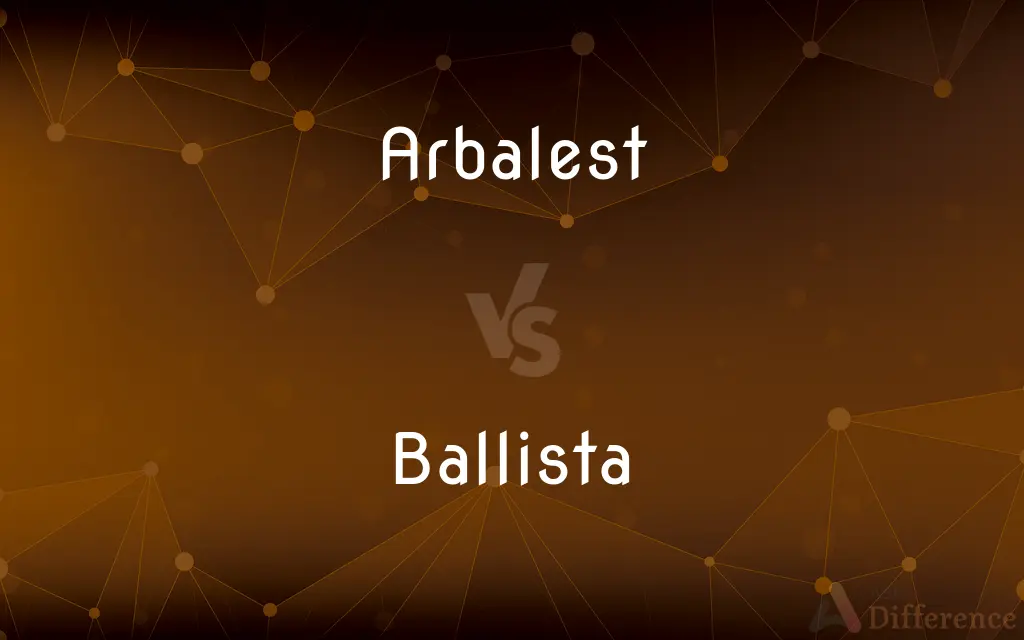Arbalest vs. Ballista — What's the Difference?
Edited by Tayyaba Rehman — By Maham Liaqat — Updated on April 15, 2024
An arbalest is a late medieval crossbow with a powerful mechanism, used for precise, short-range shots, while a ballista is an ancient siege engine designed for launching projectiles over long distances.

Difference Between Arbalest and Ballista
Table of Contents
ADVERTISEMENT
Key Differences
The arbalest, developed in the 12th century, features a robust and heavy construction, employing a metal prod (the bow part) which allows for greater force and thus increased penetration of armor. In contrast, the ballista, which predates the arbalest by centuries, originated in ancient Greece and Rome, functioning more like a giant crossbow, primarily utilized in siege warfare to hurl large bolts or stones.
While the arbalest is operated by an individual, typically a skilled crossbowman, the ballista requires a team to load, aim, and discharge due to its larger size and mechanical complexity. This makes the arbalest more suitable for mobile and responsive combat situations, whereas the ballista is more static, used for strategic positions during sieges.
The mechanism of an arbalest includes a windlass or cranequin to draw the string, a process requiring significant strength and time, highlighting its use for powerful, deliberate shots. On the other hand, the ballista uses torsion power, with twisted skeins usually made of sinew, hair, or animal gut, to propel projectiles, which allows for greater range and force, suitable for breaching fortifications or formations.
In terms of projectiles, the arbalest fires bolts, which are shorter and heavier than typical arrows, designed for armor penetration. The ballista, however, can launch a variety of ammunition, including bolts, stones, and even incendiary materials, adapted to diverse siege needs.
While the arbalest is largely seen as a weapon of personal armament in medieval armies, the ballista serves as an engineering marvel of ancient warfare, illustrating early developments in mechanical artillery. Both represent significant advancements in military technology for their respective eras.
ADVERTISEMENT
Comparison Chart
Era
Late medieval (12th century onward)
Ancient (used by Greeks and Romans)
Type
Crossbow with metal prod
Siege engine with torsion mechanism
Operation
Operated by an individual
Requires a team to operate
Projectile
Bolts (heavy and short)
Bolts, stones, incendiaries
Primary Use
Armor penetration, precise short-range shots
Long-range, breaching fortifications
Compare with Definitions
Arbalest
A powerful medieval crossbow with a steel bow, used for high impact and penetration.
The knight loaded his arbalest carefully, aiming at the approaching enemy.
Ballista
Operated by torsion with skeins of sinew or hair, launching projectiles over long distances.
The ballista crew twisted the torsion bars, preparing to launch a volley of stones.
Arbalest
Known for its robust construction and powerful discharge.
The heavy arbalest was a formidable weapon in medieval siege warfare.
Ballista
Capable of firing various types of ammunition based on battlefield needs.
For the upcoming assault, the ballista was loaded with incendiary material to ignite the enemy’s wooden barricades.
Arbalest
Features mechanisms like windlasses or cranequins for drawing the heavy string.
He turned the windlass of the arbalest, tensioning the string to its full capacity.
Ballista
Reflects ancient advancements in war engineering and tactics.
The ballista stood as a testament to Roman engineering prowess, dominating ancient battlefields.
Arbalest
Utilized by skilled crossbowmen in medieval armies.
Arbalest operators were often positioned behind infantry lines to maximize their impact.
Ballista
An ancient military siege engine resembling a large crossbow.
The engineers positioned the ballista on the hill to target the fort’s walls.
Arbalest
Primarily designed for effectiveness against armored opponents.
The arbalest bolt, driven by immense force, could penetrate even the toughest armor.
Ballista
Used in sieges to damage fortifications or target large troop formations.
The ballista’s bolts crashed into the enemy ranks, causing chaos and disarray.
Arbalest
The arbalest (also arblast) was a late variation of the crossbow coming into use in Europe during the 12th century. A large weapon, the arbalest had a steel prod ("bow").
Ballista
The ballista (Latin, from Greek βαλλίστρα ballistra and that from βάλλω ballō, "throw"), plural ballistae, sometimes called bolt thrower, was an ancient missile weapon that launched either bolts or stones at a distant target. Developed from earlier Greek weapons, it relied upon different mechanics, using two levers with torsion springs instead of a tension prod (the bow part of a modern crossbow).
Arbalest
A medieval crossbow, especially one having a steel bow and a winch or other mechanism to draw the string.
Ballista
An ancient and medieval engine of warfare, usually having a design similar to a crossbow, used to hurl heavy projectiles.
Arbalest
A crossbow.
Ballista
An ancient military engine, in the form of a crossbow, used for hurling large missiles.
Arbalest
A crossbowman.
Ballista
An ancient military engine, in the form of a crossbow, used for hurling large missiles.
Arbalest
A crossbow, consisting of a steel bow set in a shaft of wood, furnished with a string and a trigger, and a mechanical device for bending the bow. It served to throw arrows, darts, bullets, etc.
Ballista
Medieval artillery used during sieges; a heavy war engine for hurling large stones and other missiles
Arbalest
Medieval artillery used during sieges; a heavy war engine for hurling large stones and other missiles
Common Curiosities
What is a ballista?
A ballista is an ancient mechanical siege device that functioned similar to a giant crossbow, used primarily to launch large projectiles over great distances during sieges.
What are the main differences in operation between an arbalest and a ballista?
The arbalest is manually operated by a single individual using a crank or windlass, while the ballista requires a team to manage its torsion mechanism and large projectiles.
What is an arbalest?
The arbalest is a type of advanced medieval crossbow with a metal prod and mechanical aiming and loading devices, used for powerful, precise shooting.
How was the arbalest used in battle?
The arbalest was used to target enemy combatants, particularly those in armor, at relatively short ranges with high accuracy and penetrating power.
Can an arbalest be considered a personal weapon?
Yes, the arbalest can be considered a personal weapon, as it was operated by individual soldiers and required skill and strength to use effectively in combat.
What types of projectiles did a ballista use?
A ballista could fire a variety of projectiles, including large bolts, stones, and incendiaries, depending on the tactical needs of a siege.
How effective was the arbalest against armor?
The arbalest was highly effective against armor due to its powerful metal prod and heavy bolts, which could penetrate armor plates.
What strategic advantage did the ballista offer in ancient warfare?
The ballista provided the strategic advantage of long-range artillery fire, capable of breaking enemy fortifications and causing disarray among troop formations before a ground assault.
Was the ballista used in any famous historical battles?
Ballistae were used in numerous ancient battles, including sieges in Roman and Greek warfare, playing crucial roles in breaching city walls and fortresses.
How did the development of the arbalest influence medieval warfare?
The development of the arbalest marked a significant advancement in medieval military technology, enhancing infantry effectiveness with a weapon capable of defeating heavily armored foes.
Share Your Discovery

Previous Comparison
Satiric vs. Satirical
Next Comparison
Provenance vs. ProvidenceAuthor Spotlight
Written by
Maham LiaqatEdited by
Tayyaba RehmanTayyaba Rehman is a distinguished writer, currently serving as a primary contributor to askdifference.com. As a researcher in semantics and etymology, Tayyaba's passion for the complexity of languages and their distinctions has found a perfect home on the platform. Tayyaba delves into the intricacies of language, distinguishing between commonly confused words and phrases, thereby providing clarity for readers worldwide.
















































